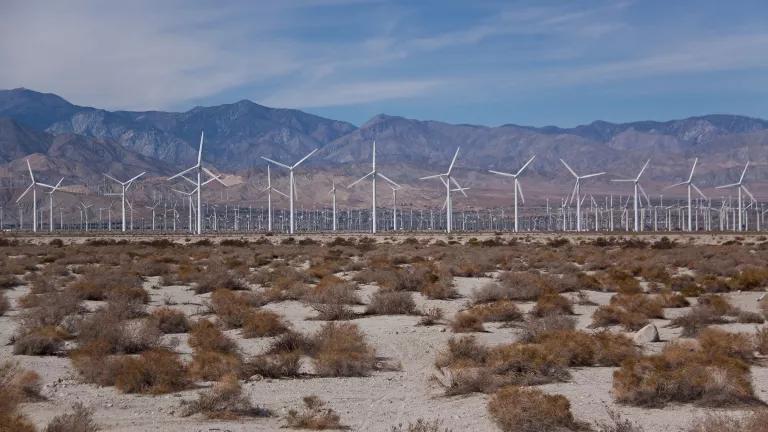California Makes a Clean Break—from Carbon Pollution
What does it mean for a state that’s bigger and wealthier than many countries to commit itself to clean energy? It could end up meaning the world.

A wind farm outside of Palm Springs, California
The world’s fifth-largest economy just made climate history—and the rest of the world really needs to sit up straight and take notice.
I’ll spare you the Google search. I’m not talking about Great Britain or France or India here; I’m talking about California. Yesterday, Governor Jerry Brown put his signature on SB 100, a bill that sets an ambitious goal for all of the state’s electricity—as in 100 percent of it—to come from carbon-free sources by the year 2045, and requires that at least 60 percent of that power comes from renewables in the next 12 years. Many nations around the globe would love to take such a big step to stave off the effects of catastrophic, civilization-busting climate change. . . if only they felt like it was possible in practical, political, and economical terms.
California could very well show them that it is. The Golden State—once the butt of jokes for its seemingly intractable smog problem—has just become the largest economy in the world to set a target of entirely carbon-free energy by 2045. (That’s the same year, coincidentally, that the Union of Concerned Scientists has predicted more than 20,000 California homes could be lost to sea-level rise if nothing is done.)
With a population approaching 40 million, California has more residents than many countries, including Poland, Peru, Malaysia, and Australia. And at approximately 164,000 square miles, it’s larger, geographically speaking, than Japan and Germany. Moreover, as anyone who’s ever been there will attest, its terrain includes a stunningly diverse mix of mountains, forests, deserts, coastlines, islands, farmlands, and cities—including one of the world’s largest, Los Angeles.
In many ways, the state is the whole world in microcosm. Any nation wondering how it could ever possibly transition to a carbon-free energy economy can and should look to California as a model; somewhere within it, they’re likely to find a reflection of themselves. Its size, economy, and diversity make it an optimal proving ground for plans to move from fossil fuels to renewables.
Questions about cost, scalability, transmission, and grid stability are legitimate, and are worthy of discussion. But too often these questions are asked in bad faith by those whose goals are really to keep fossil fuel industries puttering along as usual, typically by stoking fear and sowing doubt. Instead of letting any uncertainties halt progress and hold clean energy back, however, California lawmakers are committing their state to finding answers and implementing solutions—in appropriate recognition that time is scarce, and the stakes of delay are too high. Their resolve stands as a forceful rebuttal to arguments that clean energy alternatives to fossil fuels are too risky or too expensive.

Dan Jacobson, who leads Environment California, the statewide environmental organization that fought vigorously for SB 100’s passage, told reporters that the new law represents “a response to the threat of climate change and to the inaction in Washington, D.C.” As the state suffers through one of its most destructive wildfire seasons and ponders the effects of sea-level rise on its long coastline, California is no longer waiting for the federal government to get serious about global warming's impacts.
Hawaii isn’t waiting either—having already made a commitment last April to go carbon-free by 2045—and other states are setting similar goals, among them New York, New Jersey, and Massachusetts. But the fact that our most populous and economically powerful state is working toward ditching fossil fuels should only embolden these states and others to act more quickly, and with far more certainty that the politics and economics of going all-in on renewables are changing rapidly and exponentially, right along with the technology. If tiny Hawaii opened the door, California tore the door off its hinges.
Tomorrow, San Francisco will host hundreds of scientists, advocates, thought leaders, and policy experts at the Global Climate Action Summit. In addition to discussing the many challenges ahead, attendees will share stories of progress made, hurdles overcome, and cynicism vanquished. They’ll ask what’s next—what can be done right now, in the present moment, to prevent future disaster. They’ll seek examples of political bravery, informed by scientific expertise and economic confidence. And one of the brightest and best examples will quite literally be all around them.
This article was originally published on onEarth, which is no longer in publication. onEarth was founded in 1979 as the Amicus Journal, an independent magazine of thought and opinion on the environment. All opinions expressed are those of the authors and do not necessarily reflect the policies or positions of NRDC. This article is available for online republication by news media outlets or nonprofits under these conditions: The writer(s) must be credited with a byline; you must note prominently that the article was originally published by NRDC.org and link to the original; the article cannot be edited (beyond simple things such grammar); you can’t resell the article in any form or grant republishing rights to other outlets; you can’t republish our material wholesale or automatically—you need to select articles individually; you can’t republish the photos or graphics on our site without specific permission; you should drop us a note to let us know when you’ve used one of our articles.


How to Ditch the Biggest Fossil Fuel Offenders in Your Life
What Are the Solutions to Climate Change?
Meet the Federal Energy Regulatory Commission